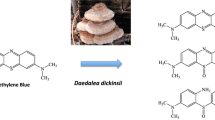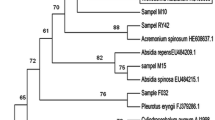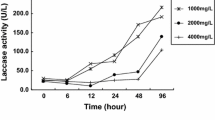Abstract
An investigation was conducted to assess the ability of three species of brown-rot fungi to decolorize and transform methyl orange dye. Methyl orange was decolorized in a potato dextrose agar medium by Fomitopsis pinicola, Gloeophyllum trabeum, and Daedalea dickinsii at different concentrations of 50, 75, and 100 mg L−1. Based on the values of the decolorization index, the highest methyl orange decolorization was found approximately 91% by F. pinicola, followed by D. dickinsii and G. trabeum of 82% and 76%, respectively, at a concentration of 50 mg L−1. F. pinicola had the highest methyl orange transformation with percent decolorization values of approximately 97%, followed by D. dickinsii and G. trabeum of 93% and 67%, respectively, after a 14-day incubation period in potato dextrose broth. F. pinicola transformed methyl orange into six metabolic products: compounds 3, 6, 7, 8, 9, and 10, while G. trabeum transformed methyl orange into five metabolic products: compounds 1, 2, 3, 4, and 5. Among brown-rot fungi, D. dickinsii had more metabolic products, with compounds 3, 4, 6, 11, 12, 13, 14, 15, 16, 17, and 18. Based on the identification of metabolic products, novel bio-transformation was proposed that brown-rot fungi initially transformed methyl orange via three pathways: (1) demethylation, (2) desulfonylation, and (3) hydroxylation. This study indicated that brown-rot fungi can be used to decolorize and transform methyl orange dye as well as proposed novel bio-transformation of methyl orange by brown-rot fungi.


Similar content being viewed by others
References
Abramian L, El-Rassy H (2009) Adsorption kinetics and thermodynamics of azo-dye Orange II onto highly porous titania aerogel. Chem Eng J 150:403–410
Akamatsu Y, Takahashi M, Shimada M (1992) Cell-free extraction and assay of oxaloacetate from the brown-rot fungus Tyromyces palustris. Mokuzai Gakkaishi 38:495–500
Ayed L, Khelifi E, Jannet HB, Miladi H, Cheref A, Achour S, Bakhrouf A (2010) Response surface methodology for decolorization of azo dye Methyl Orange by bacterial consortium: produced enzymes and metabolites characterization. Chem Eng J 165:200–208
Bazrafshan E, Zarei AA, Nadi H, Zazouli MA (2014) Adsorptive removal of Methyl Orange dan Reactive Red 198 dyes by Moringa peregrina ash. Indian J Chem Techn 21:105–113
Bigg T, Judd S (2001) Kinetics of reductive degradation of azo dye by zero-valent iron. Process Saf Environ Prot 79(5):297–303
Bokare AD, Chikate RC, Rode CV, Paknikar KM (2008) Iron-nickel bimetallic nanoparticles for reductive degradation of azo dye Orange G in aqueous solution. Appl Catal B Environ 79(3):270–278
Camargo BCV, Morales MAM (2013) Azo dyes: characterization dan toxicity-A review. Text Light Indus Sci Techn (TLIST) 2:85–103
Chacón JM, Leal MT, Sánchez M, Bandala ER (2006) Solar photocatalytic degradation of azo-dyes by photo-Fenton process. Dyes Pigm 69(3):144–150
Chen C, Liu J, Liu P, Yu B (2011) Investigation of photocatalytic degradation of methyl orange by using nano-sized ZnO catalysts. Adv Chem Eng Sci 1(01):9–14
D’Souza TM, Boominathan K, Reddy CA (1996) Isolation of laccase gene-specific sequences from white rot and brown rot fungi by PCR. App Environ Microb 62(10):3739–3744
Del Nero J, de Araujo RE, Gomes ASL, de Melo CP (2005) Theoretical and experimental investigation of the second hyperpolarizabilities of methyl orange. J Chem Phys 122:104506
Du LN, Li G, Zhao YH, Xu HK, Wang Y, Zhou Y, Wang L (2015) Efficient metabolism of the azo dye methyl orange by Aeromonas sp. strain DH-6: characteristics and partial mechanism. Int Biodeterior Biodegrad 105:66–72
Dutton MV, Evans CS (1996) Oxalate production by fungi: its role in pathogenicity and ecology in the soil environment. Can J Microb 42:881–895
Espejo E, Agosin E (1991) Production and degradation of oxalic acid by brown rot fungi. App Environ Microbiol 57(7):1980–1986
Fenton HJH (1894) Oxidation of tartaric acid in presence of iron. J Chem Soc 65:899–910
Gomaa OM, Kareem H, Fatahy R (2010) Assessment of the efficacy of brown rot fungi in real textile waste water treatment. J Biotech 150:261
Gomathi DL, Girish KS, Mohan RK, Munikrishnappa C (2009) Photo degradation of methyl orange an azo dye by advanced Fenton process using zero valent metallic iron: influence of various reaction parameters and its degradation mechanism. J Hazard Mater 164(2–3):459–467
Grizca BE, Setyo PA (2018) Abilities of co-cultures of white-rot fungus Ganoderma lingzhi and bacteria Bacillus subtilis on biodegradation DDT. J Phys Conf Ser 1095:102015
Gutowska A, Czaplinska J, Jozwiak W (2007) Degradation mechanism of reactive Orange 113 dye by H2O2/Fe2+ and ozone in aqueous solution. Dyes Pigm 74:41–46
Jadhav SU, Kalme SD, Govindwar SP (2008) Biodegradation of Methyl red by Galactomyces geotrichum MTCC 1360. Int Biodeterior Biodegrad 62:135–142
Jayasinghe C, Imtiaj A, Lee GW, Im KH, Hur H, Yang HS, Lee TS (2008) Degradation of three aromatic dyes by white rot fungi and the production of ligninolytic enzymes. Mycobiology 36:114–120
Koenigs JW (1974) Hydrogen peroxide and iron: a proposed system for decomposition of wood by brown-rot basidiomycetes. Wood Fiber 6:66–80
Levin L, Grassi E, Carballo R (2012) Efficient azoic dye degradation by Trametes trogii and a novel strategy to evaluate products released. Int Biodeterior Biodegrad 75:214–222
Liakou S, Pavlou S, Lyberatos G (1997) Ozonation of azo dyes. Water Sci Technol 35(4):279–286
Mahmood RT, Asad MJ, Asgher M, Gulfraz M, Mukhtar T (2017) Analysis of lingolytic enzymes and decolorization of dispere violet S3RL, yellow brown S2RFL, red W4BS, yellow SRLP and red S3B by brown rot fungi. Pak J Agric Sci 54(2):407–413
Newcombe D, Paszcynsky A, Gajewska W, Kroger M, Feis G, Crawford R (2002) Production of small molecular weight catalyst and the mechanism of trinitrotoluene degradation by several Gloeophyllum species. Enzyme Microb Technol 30:506–517
Park N, Park SS (2014) Purification and characterization of a novel laccase from Fomitopsis pinicola mycelia. Int J Biol Macromol 70:583–589
Parshetti GK, Telke AA, Kalyani DC, Govindwar SP (2010) Decolorization and detoxification of sulfonated azo dye methyl orange by Kocuria rosea MTCC 1532. J Hazard Mater 176:503–509
Peternel IT, Koprivanac N, Božić AML, Kušić HM (2007) Comparative study of UV/TiO2, UV/ZnO and photo-Fenton processes for the organic reactive dye degradation in aqueous solution. J Hazard Mater 148(1):477–484
Purnomo AS (2017) Microbe-assisted degradation of aldrin and dieldrin. In: Singh SN (ed) Microbe-induced degradation of pesticides, 1st edn. Springer, Basel, pp 1–22
Purnomo AS, Kamei I, Kondo R (2008) Degradation of 1,1,1-trichlro-2,2-bis (4-chlorophenyl) ethane (DDT) by brown-rot fungi. J Biosci Bioeng 105:614–621
Purnomo AS, Koyama F, Mori T, Kondo R (2010a) DDT degradation potential of cattle manure compost. Chemosphere 80(6):619–624
Purnomo AS, Mori T, Kamei I, Nishii T, Kondo R (2010b) Application of mushroom waste medium from Pleurotus ostreatus for bioremediation of DDT-contaminated soil. Int Biodeterior Biodegrad 64(5):397–402
Purnomo AS, Mori T, Kondo R (2010c) Involvement of Fenton reaction in DDT degradation by brown rot fungi. Int Biodet Biodeg 64:560–565
Purnomo AS, Mori T, Takagi K, Kondo R (2011a) Bioremediation of DDT contaminated soil using brown-rot fungi. Int Biodet Biodeg 65:691–695
Purnomo AS, Mori T, Kamei I, Kondo R (2011b) Basic studies and applications on bioremediation of DDT: a review. Int Biodet Biodeg 65(7):921–930
Purnomo AS, Mori T, Putra SR, Kondo R (2013) Biotransformation of heptachlor and heptachlor epoxide by white-rot fungus Pleurotus ostreatus. Int Biodet Biodeg 82:40–44
Purnomo AS, Putra SR, Shimizu K, Kondo R (2014) Biodegradation of heptachlor and heptachlor epoxide-contaminated soils by white-rot fungal inocula. Environ Sci Pollut Res 21:11305–11312
Purnomo AS, Nawfa R, Martak F, Shimizu K, Kamei I (2017a) Biodegradation of aldrin and dieldrin by the white-rot fungus Pleurotus ostreatus. Curr Microbiol 74(3):320–324
Purnomo AS, Ashari K, Hermansyah F (2017b) Evaluation of the synergistic effect of mixed cultures of white-rot fungus Pleurotus ostreatus and biosurfactant-producing bacteria on DDT biodegradation. J Microbiol Biotechnol 27(7):1306–1315
Rafii F, Hall JD, Cerniglia CE (1997) Mutagenicity of azo dyes used in foods, drugs and cosmetics before and after reduction by Clostridium species from the human intestinal tract. Food Chem Toxic 35(9):897–901
Ramirez C, Saldana A, Hernandez B, Acero R, Guerra R, Garcia-Segura S, Brillas E, Peralta-Hernandez JM (2013) Electrochemical oxidation of methyl orange azo dye at pilot flow plant using BDD technology. J Indus Eng Chem 19:571–579
Rizqi HD, Purnomo AS (2017) The ability of brown-rot fungus Daedalea dickinsii to decolorize and transform methylene blue dye. World J Microbiol Biotechnol 33(5):92
Roy A, Adhikari B, Majumder SB (2013) Equilibrium, kinetic, and thermodynamic studies of azo dye adsorption from aqueous solution by chemically modified lignocellulosic jute fiber. Ind Eng Chem Res 52(19):6502–6512
Sariwati A, Purnomo AS (2018) The effect of Pseudomonas aeruginosa addition on 1,1,1 Trichloro 2,2 bis (4 chlorophenyl) ethane DDT Biodegradation by Brown-Rot fungus Fomitopsis pinicola. Indones J Chem 18(1):75–81
Sariwati A, Purnomo AS, Kamei I (2017) Abilities of co-cultures of brown-rot fungus Fomitopsis pinicola and Bacillus subtilis on biodegradation DDT. Curr Microbiol 74:1068–1069
Saroj S, Kumar K, Pareek N, Prasad R, Singh RP (2014) Biodegradation of azo dyes Acid Red 183, Direct Blue 15 and Direct Red 75 by the isolate Penicillium oxalicum SAR-3. Chemosphere 107:240–248
Schlosser D, Fahr K, Karl W, Wetzstein HG (2000) Hydroxylated metabolites of 2,4-dichlorophenol imply a Fenton-type reaction in Gloeophyllum striatum. App Environ Microb 66:2479–2483
Seesuriyachan P, Takenaka S, Kuntiya A, Klayraung S, Murakami S, Aoki K (2007) Metabolism of azo dyes by Lactobacillus casei TISTR 1500 and effects of various factors on decolorization. Water Res 41:985–992
Setyo PA, Dwi RH, Sri F, Sulistyo PH, Ichiro K (2018) Effects of bacterium Ralstonia pickettii addition on DDT biodegradation by Daedalea dickinsii. Res J Chem Environ 22(Special issue II):151–156
Shah MP, Patel KA, Darji A (2013) Microbial degradation and decolorization of methyl Orange dye by an application of Pseudomonas spp. ETL-1982. Int J Environ Bioremediat Biodegrad 1:26–36
Singh RL, Singh PK, Singh RP (2015) Enzymatic decolorization and degradation of azo dyes-a review. Int Biodeterior Biodegrad 104:21–31
Singla P, Sharma M, Pandey OP, Singh K (2014) Photocatalytic degradation of azo dyes using Zn-doped and undoped TiO2 nanoparticles. Appl Phys A 116(1):371–378
Sudha M, Saranya A, Selvakumar G, Sivakumar N (2014) Microbial degradation of azo dyes: a review. Int J Curr Microbiol App Sci 3:670–690
Takao S (1965) Organic acid production by Basidiomycetes. I. Screening of acid-producing strains. App Microbiol 13(5):732–737
Thao TP, Kao HC, Juang RS, Lan JCW (2013) Kinetic characteristics of biodegradation of methyl orange by Pseudomonas putida mt2 in suspended and immobilized cell systems. J Taiwan Inst Chem Eng 44:780–785
Vasdev K (2011) Decolorization of triphenylmethane dyes by six white-rot fungi isolated from nature. J Bioremed Biodegrad 2(5):61–66
Wahyuni S, Suhartono MT, Khaeruni A, Purnomo AS, Asranudin Holilah, Riupassa PA (2016) Purification and characterization of thermostable chitinase from Bacillus SW41 for chitin oligomer production. Asian J Chem 28(12):2731–2736
Wahyuni S, Khaeruni A, Purnomo AS (2017) Characterization of mannanase isolated from corncob waste bacteria. Asian J Chem 29(5):1119–1120
Wetzstein HG, Schemer N, Karl W (1997) Degradation of fluoroquinolone enrofloxacin by the brown rot fungus Gloeophyllum striatum: identification of metabolites. App Environ Microb 63:4272–4281
Wetzstein HG, Stadler M, Tichy HV, Dalhoff A, Karl W (1999) Degradation of ciprofloxacin by basidiomycetes and identification of metabolites generated by the brown rot fungus Gloeophyllum striatum. App Environ Microb 65:1556–1563
Wood PM (1994) Pathways for production of Fenton’s reagent by wood-rooting fungi. FEMS Microb Rev 13:313–320
Wu J, Doan H, Upreti S (2008) Decolorization of aqueous textile reactive dye by ozone. Chem Eng J 142:156–160
Yildirim AÖ, Gül Ş, Eren O, Kuşvuran E (2011) A comparative study of ozonation, homogeneous catalytic ozonation, and photocatalytic ozonation for C.I. Reactive Red 194 azo dye degradation. CLEAN Soil Air Water 39(8):795–805
Zeng G, Cheng M, Huang D, Lai C, Xu P, Wei Z, Li N, Zhang C, He X, He Y (2015) Study of the degradation of methylene blue by semi-solid-state fermentation of agricultural residues with Phanerochaete chrysosporium and reutilization of fermented residues. Waste Manag 38:424–430
Zhu GC, Shou JX, Qian JW, Xin HZ, Qiu MQ (2014) Degradation of Methylene Blue by Fenton-like reaction. J Adv Mater Res 1065–1069:3127–3130
Acknowledgements
This work was supported by the competency-based research Grant No. 1/E/KPT/2018 from the Directorate General of Strengthening Research and Development, Ministry of Research, Technology and Higher Education, Indonesia.
Author information
Authors and Affiliations
Corresponding author
Additional information
Editorial responsibility: J Aravind.
Rights and permissions
About this article
Cite this article
Purnomo, A.S., Mauliddawati, V.T., Khoirudin, M. et al. Bio-decolorization and novel bio-transformation of methyl orange by brown-rot fungi. Int. J. Environ. Sci. Technol. 16, 7555–7564 (2019). https://doi.org/10.1007/s13762-019-02484-3
Received:
Revised:
Accepted:
Published:
Issue Date:
DOI: https://doi.org/10.1007/s13762-019-02484-3




